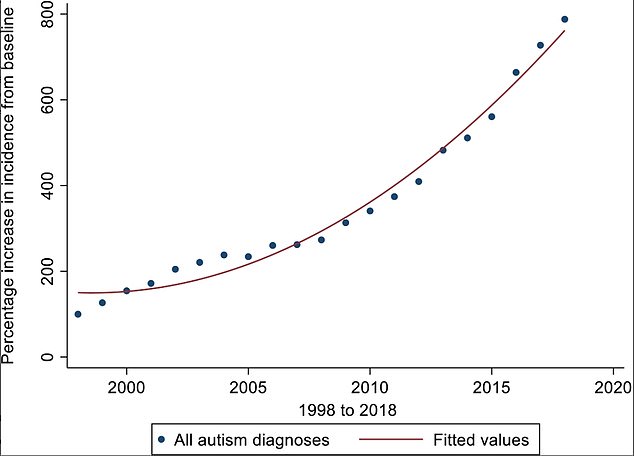Scientists have discovered there are four different and distinct types of autism in a step they have called a ‘paradigm shift’ for future treatment of the disorder.
US experts who examined data from 5,000 children found the condition could be broken down into four types, each with different implications for children and their families.
The most common type was the ‘Social and Behavioural Challenges’ group, who accounted for 37 per cent of cases.
Experts found this group showed core autistic traits like challenges with socialising and repetitive behaviours but no developmental challenges.
However, the scientists found patients with this type of autism are often diagnosed later in life.
The team also found this group were more likely to develop other mental health problems like attention deficit hyperactivity disorder (ADHD), anxiety, depression or obsessive-compulsive disorder (OCD).
Critically, scientists also found the genes linked to this type of autism are linked with later childhood development which could explain the delayed diagnosis, they said.
The second most common type of autism was called the ‘Moderate Challenges’ group, at 34 per cent.

Scientists have discovered there are four different and distinct types of autism in a step they have called a ‘paradigm shift’ for future treatment of the disorder. Stock image
Patients with this type of the disorder were similar to the ‘Social and Behavioural Challenges’ group but weren’t at heighted risk of developing mental health conditions.
The third most common type was ‘Mixed ASD (autism spectrum disorder) with Developmental Delay’, which affected about one in five children.
These children tended to reach developmental milestones—like walking and talking—later than those without autism but didn’t have a higher risk of mental health conditions found in the other types.
They also showed a ‘mix’ of autistic traits like repetitive behaviours and social challenges and were more likely to have rare genetic traits linked to autism.
The final type of autism identified by the researchers, from Princeton University in New Jersey, was called ‘Broadly Affected’.
This group—which only accounted for one in 10 cases—experienced the most extreme autism symptoms and suffered profound developmental delays as well as greater risk of other mental health conditions.
Of the four types, ‘Broadly Affected’ children had the highest proportion of harmful ‘de novo’ mutations in their genes.
These are mutations that are not inherited directly from a parent but occur independently as child develops in the womb.

This chart shows the percentage increase in incidence of autism diagnosis from 1998 to 2018. UK researchers found autism diagnoses had risen by an ‘exponential’ 787% over 20 years. They said the rise could be due to increased recognition of the condition among experts particularly in diagnosing autism among girls and adults, but added an increase in cases of autism itself cannot be ruled out
Professor Olga Troyanskaya, an expert in analysis of genomic data and senior author of the study, said the discovery could help unlock faster diagnosis and more bespoke treatments for autistic people.
‘Understanding the genetics of autism is essential for revealing the biological mechanisms that contribute to the condition, enabling earlier and more accurate diagnosis, and guiding personalised care,’ she said.
Psychologist Jennifer Foss-Feig, another author of the study, added that knowing a child’s autism subtype could help parents spot key signs of mental health conditions or developmental issues.
‘It could tell families, when their children with autism are still young, something more about what symptoms they might—or might not—experience, what to look out for over the course of a lifespan, which treatments to pursue, and how to plan for their future,’ she said.
In the study, published in Nature Genetics, the experts analysed data from 5,000 children taking part in a long-running autism study.
They looked for 230 traits linked to the disorder in each child and then assigned them to one of the four sub-types.
The scientists then cross referenced that with genetic data to identify any genes linked to the disorder.
The authors emphasised that the four types of autism is just a foundation, and there may be more or sub-types within each group, adding this was an area of further research.
Their discovery comes amid rising concern autism may be over diagnosed in England, with an eight-fold increase in cases in recent decades.
British researchers have said shocking rise is likely due to increased awareness of the condition but have added an increase in prevalence could also be contributing.
An additional factor experts say could be influencing the rise is the retirement of Asperger’s syndrome.
This was once considered a separate condition but is now considered another form of autism.
However, others have pointed to the ‘wild-west’ of autism screening in England that could mean over-diagnosis could also be playing a part.
Last year a study revealed adults referred to some autism assessment facilities have an 85 per cent chance of being told they are on the spectrum.
Yet the figure can be as low as 35 per cent in other places, researchers at University College London found.
Official NHS data shows more than 200,000 people are now waiting for an autism assessment in England, with some having been on the list for years.
Autism charities have said it is unacceptable that the equivalent of the population of Luton or Portsmouth is now waiting to been seen by a specialist.
According to the World Health Organisation, about one in 100 children across the globe has autism.
Signs in adults include not understanding how others are feeling, getting anxious about social situations, having a strict routine or seeming blunt without meaning to.
Autistic children may avoid eye contact and not respond to their name being called, among other symptoms.
Autism is not a disease and people have it from the moment they are born, although it may not be spotted until childhood and sometimes much later.
The condition exists on a spectrum. Some people will be able to lead fully functioning lives with no additional help. Others may need full-time assistance.












